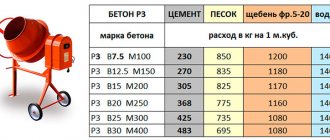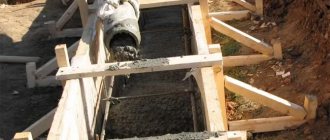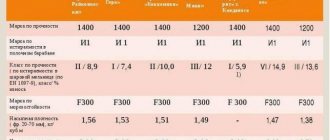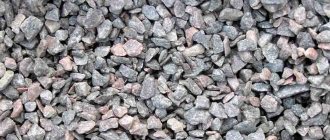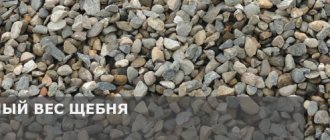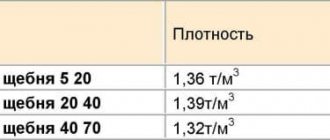Quartzite (quartzite) crushed stone. Photos of Soil Trucks
Crushed stone is a fractional material in demand in various fields of activity. Crushed stone is especially actively used in construction.
But before starting work, it is necessary to calculate the amount or volume of crushed stone.
Important characteristics of crushed stone
The calculated indicators are influenced by many factors related to various features. Large-scale estimates are prepared by serious construction companies, which take into account the key parameters of crushed stone when calculating.
When calculating, the following parameters are taken into account:
- Flakiness. The robust material has cube-shaped components. The bulk weight of the material is influenced by the shape itself. This property is important when preparing concrete products. The compaction coefficient depends on the parameter, in other words, a high value means a low compaction parameter.
- Fraction. The smaller the pebbles of material, the more will fit into the same volume. For example, for a fraction from five to twenty millimeters, the mass of one cubic meter is one thousand three hundred and sixty kilograms, and for a larger fraction from forty to seventy millimeters it is 1320 kilograms.
- Moisture absorption. This characteristic depends on the type of rock, as well as on the volume of the fraction.
- True density. Different types have different densities. The mass of stones can differ significantly from each other. For example, one cubic meter of granite weighs more than two and a half tons, and one cubic meter of limestone weighs about two tons.
How to count without errors
The type of foundation is determined not by the wishes of the building owner, but by natural conditions and load requirements. Therefore, the type of base is chosen only after conducting research on the depth of soil freezing and its type.
For the foundation
The latter could be:
- tape;
- pile;
- columnar with grillage;
- in the form of a solid slab.
For tape base
The strip type of base is suitable for low buildings, outbuildings, shops and warehouses. It looks like a ribbon running under all load-bearing walls and partitions, which is why it got its name.
For pile type foundation
To calculate the volume of concrete when installing rectangular piles, you will need to multiply the length by the width and height of the pile. Then the resulting figure is multiplied by the desired number of piles.
Calculating concrete for round piles is a little more difficult.
The error in calculating concrete for a pile foundation is minimal. This is due to the fact that there are no voids or reinforcement inside the piles.
For a columnar base with a reinforced concrete grillage
Not knowing how to calculate cubes of concrete for such a structure, builders make the mistake of taking into account only the length, width and height of most of the foundation, that is, the grillage. In such cases, the solution is not enough to cover the depth of the piles.
Correct calculations prevent the situation:
- Calculate the amount of mortar for supports according to the algorithm for a pile-type foundation.
- Determine the volume of concrete for the grillage in the same way as for a strip foundation.
- Add the resulting values.
If the calculations are carried out correctly, the error in them will be no more than 5%.
For a solid slab foundation
Before calculating the cubic capacity of concrete for a slab base, you will need to determine the perimeter of the walls of the future building - the slab must protrude beyond their boundaries. Calculations are carried out using the formula “length*width*height”.
For building walls
The error in calculations is provided not only by concrete shrinkage, but also by wall reinforcement.
For filling the floor
This technology only works if the base for the screed does not have slopes or drops, which is practically never encountered in construction practice.
When calculating, take into account the composition of concrete and the type of screed. The roughing is done with the same mixture that is used to fill the walls and foundation. When creating a leveling layer, you will need to choose concrete without crushed stone, shell rock and other large fractions.
Main characteristics of different types of crushed stone
Crushed stone, by type of origin, is a decorative/construction element of a non-metallic type. It is used in the construction and repair industries in the form of products for performing construction tasks.
Additionally, it can be used as a material that is included in the list of ingredients for special solutions when developing various structures, products or elements made of reinforced concrete.
According to the location of raw material extraction, there are three following groups:
- mountain;
- river;
- nautical.
All three types have the following characteristics:
- high strength;
- stability in low temperatures;
- resistance to wear during use.
Suppliers of crushed stone must indicate the level of frost resistance for all shipments. This characteristic is important as it affects the fractional dimensions, cross-section of the edges, as well as density.
Types of concrete mixtures
The concrete mixture is prepared in special mixers; it contains crushed stone, sand and cement. Mixtures are divided into types.
By purpose
There are two types in total:
- Commonly used for the manufacture of structural elements of buildings, such as foundations, slabs, columns, wall panels. If the mixture contains fine filler, then this material is used for finishing.
- Special mixtures are used for the construction of bridges, dams, roads, hydroelectric power stations, and airfields. There are thermal insulation and finishing compounds, including those with decorative stones, resistant to aggressive environments, with high fire resistance, sound absorption, and X-ray resistant.
concrete mixture
By severity
The weight of the concrete mixture depends on the filler, that is, the mass of concrete and filler are directly proportional.
Types according to the severity of concrete:
- Particularly heavy. These are special compounds designed for heavy loads. This also includes X-ray resistant concrete filled with lead or cast iron shot to contain radiation.
- Heavy. Basalt, limestone or granite is added as filler. Used to make precast concrete.
- Easy. These are expanded clay concrete, wood concrete, perlite concrete, expanded clay concrete and vermiculite concrete. The density in the solid state is low, therefore with low weight. Used as insulation.
- Particularly light. This composition includes weightless lightweight fillers, for example, expanded polystyrene, tyrsa- or peat concrete. The material is used for insulation.
According to workability
This criterion promotes water retention, and this ability depends on the ingredients included in its composition.
According to the calculations carried out, based on GOST, the longer the duration of the content of water in the mixture and no delamination is observed, the more convenient the concrete is considered to be laid.
By binder concentration
This criterion determines the ratio of filler and binder. Concrete mixtures are prepared based on technical standards, but it is possible to prepare according to your own recipe.
Concrete mixtures by type of binder:
- Skinny. The concentration of the binder is low, and therefore the brand is also low.
- Fatty. The binder is added in high concentrations, so the concrete has high strength and ductility.
- Commodity. These are mixtures prepared according to standards with quality certificates, the strength characteristics are standard, and no deformations are observed.
By mobility
This property is characterized by spreading under the influence of its own mass. The mixture spreads more if it is lighter, but this depends on the amount of plasticizer and the amount of liquid.
According to the current technical conditions, the following types of mobility are divided:
- Sedentary. P1.
- Movable. P 2.
- Highly mobile. P3.
- Cast. P4.
The shrinkage of concrete is measured by the slipping of the mixture after lifting the cone into which it is previously poured.
Features of volume calculation
When calculating volume, pay special attention to the following features:
- thickness of the layer required for filling;
- total volumes of work carried out;
- specific gravity;
- compaction coefficient.
The standard compaction factor is 1.3. This value shows how much to compact the stones using a roller or vibrating plate.
Specific gravity or layer thickness indicators are indicated in a special certificate. If there is no certificate, then the average values for this type must be used. The density of the embankment is much lower than the true one, since the calculation is carried out without taking into account the voids between the stones of the material.
Example calculation for a foundation
Let's look at an example of how to calculate the number of crushed stones for a foundation. Initially, it is necessary to identify the amount of crushed stone per cubic meter. The minimum layer thickness is twenty centimeters.
The required volume is determined by the well-known formula: the product of height, width and length.
In the case under consideration, we get 1 x 1 x 0.2 = 0.2 cubic meters.
The resulting result must be multiplied by the specific gravity of crushed stone, as well as by the compaction coefficient.
In the example under consideration, we obtain the following product: 0.2 cubic meters is multiplied by 1.47 tons and by 1.3.
The result is 0.382 cubic meters. This value is the consumption of crushed stone per 1 cubic meter of foundation. The resulting indicator should be multiplied by the total area.
In this way, the exact amount of crushed stone required to develop the structure is calculated.
The concrete from which the foundation will be made must be B 25 or at least M 300. The composition includes the following elements:
- cement M400 – 380 kilograms;
- sand – 705 kilograms;
- water – 220 l;
- crushed stone - 1080 kilograms.
The figures are consumption per cubic meter.
Andrey Oskalenko from Izhevsk asks:
How to calculate the volume of crushed stone for backfilling per square meter or entire area? What does the calculation depend on or is there a general formula? Is there a difference between a decorative material and a construction or technical material? We need an option for both the landscape and the foundation.
Our specialist's answer:
There is no general formula by which you can calculate the volume of crushed stone for backfilling. Each type of material, depending on its technical and physical qualities, has separate calculation formulas. The grain size and quality of the crushed stone play an important role in this.
Calculation of crushed stone for the road
You can calculate the required amount of crushed stone for developing a road surface using the above principle. The key difference in the formula is the layer thickness. Here you will only need fifteen centimeters, so the volume will be 0.15 cubic meters. Therefore, costs are calculated as follows: 0.15 cubic meters multiplied by 1.47 tons and 1.3. The result is 2.87 cubic meters.
The error in such calculations is reduced to a minimum. For this reason, the formula is used by developers and builders to calculate the number of materials required for small projects.
Consumption of crushed stone per 1 m³ of concrete
Specialists use a simple element ratio of 1:3:5 to create concrete. One share of cement is mixed with three shares of sand and five shares of crushed stone. Additionally, water is added to obtain the required viscosity. Under the conditions of correct and correct work, it is necessary to prepare concrete of the specified grade, which determines the grade of cement, crushed stone material, sand fineness modulus and the exact mass of all components.
Consumption in concrete depends entirely on its brand. Preparation is carried out in accordance with all prepared documentation and instructions from a specialist.
In the field of construction work, there are special signs that are designed to calculate the amount of ingredients and prepare concrete of various grades. For example, to produce one cubic meter of M 300 concrete, you will need to mix and combine the following components:
- three hundred eighty-two kilograms of cement M 400;
- one thousand eighty kilograms of crushed stone;
- seven hundred and five kilograms of sand;
- two hundred and twenty liters of water.
For concrete M75 you will need slightly different ratios of components:
- one hundred seventy-five kilograms M 300;
- nine hundred forty-five kilograms of sand;
- two hundred and ten liters of water;
- 1053 kilograms of crushed stone.
Component Requirements
It is important to understand what values of concrete properties and what grade of concrete are required. Therefore, the components of the concrete composition must meet certain requirements to obtain an artificial stone that has the specified quality parameters. When selecting, you should consider:
- for cements - setting time interval, volume (weight), activity;
- for sand - purity, humidity, size and shape of fractions, volume (weight), voidness;
- for crushed stone - size and shape of grain fractions (concentration of lamellar and needle-shaped forms), weight (volume), strength, moisture absorption, cleanliness;
- for water - purity, volume.
These parameters form the final brand indicators of concrete characteristics, as well as equally important intermediate indicators of properties - workability and density of the solution. Inattention to the initial quality of crushed stone, cement, water and sand leads to a shortage of brand values, for example, the strength of structures.
Consumption of crushed stone per 1 m² of road
During road construction, the layer is compacted with a road roller or vibrating plate. There is an increase in density - this moment is taken into account as the compaction coefficient.
The consumption of material for the cushion of a monolithic slab is carried out in several steps. The thickness of the compacted layer is one hundred and fifty millimeters, and the base area is one hundred and twenty meters square.
Initially, you need to calculate the volume of the crushed stone layer: 0.15 meters multiplied by 120 square meters. The result is 18 cubic meters.
At the next stage, it is necessary to determine the amount of crushed stone in kilograms. The calculation is as follows: 18 cubic meters multiplied by 1470 kg/m³ and 1.3. The result is 34,398 kilograms or 34.5 tons.
To get accurate results, it is best to turn to professionals.
Calculation of crushed stone cubic capacity
The correctness of the structures being built, the road or the foundation, depends on the correct calculation of the material. It is necessary to take into account the compaction coefficient of crushed stone after compaction. This characteristic must be indicated in the attached documentation. All necessary information is indicated by the manufacturer or seller for all batches of goods, based on laboratory measurements. GOST defines this standard indicator. The value shows how much crushed stone is compacted during compaction, that is, to reduce its external volume.
The compaction coefficient is of the following types:
- gravel – 1.1;
- sand-gravel mixture – 1.2;
- construction sand – 1.15.
Purchasing building materials directly from the manufacturer, without resorting to resellers and intermediaries, is the best and most reliable option.
Component ratio
This indicator is decisive for the production of a high-quality solution. Various types of aggregate can be added to the solution - dolomite, slag, recycled, gravel or granite. The first three have low and medium strength up to M800, the fourth and fifth can be used in heavy solutions and have indicators from M800 to M1200. Another important factor is the size of the filler being poured; the larger it is, the stronger the solution will be. The ratios of components in one cube of concrete are presented in the table:
| Concrete grade | Proportions of cement, sand and crushed stone | |
| for M400 | for M500 | |
| M100 | 1:4,1:6,1 | 1:5,3:7,1 |
| M150 | 1:3,2:5 | 1:4:5,8 |
| M200 | 1:2,5:4,2 | 1:3,2:4,9 |
| M250 | 1:1,9:3,4 | 1:2,4:3,9 |
| M300 | 1:1,7:3,2 | 1:2,2:3,7 |
| M400 | 1:1,1:2,4 | 1:1,4:2,8 |
| M450 | 1:1:2,2 | 1:1,2:2,5 |
The main requirement for the crushed stone used is that it must be the same size and not contain foreign impurities that significantly reduce the quality of the solution. Keeping the volumetric and mass parts of aggregates specified in the proportions will allow us to produce high-quality material with the declared characteristics.
